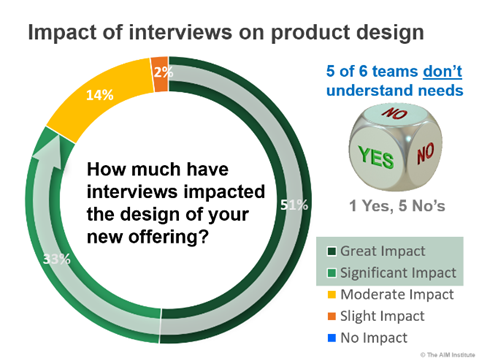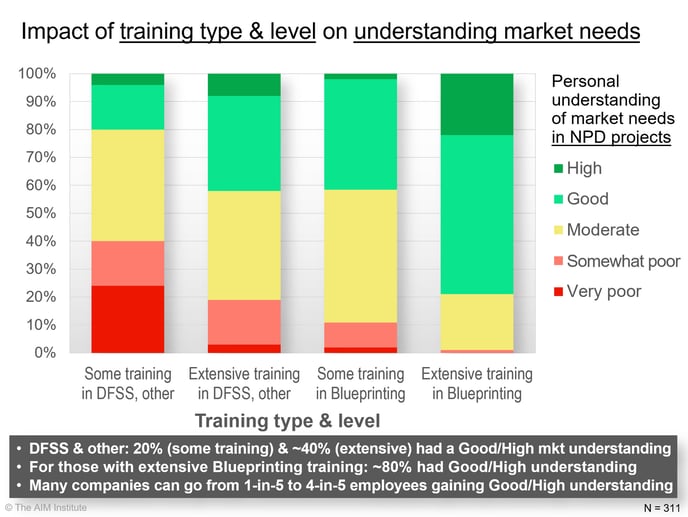Research reports and client case stories on Blueprinting effectiveness.
We’ve done considerable research to see how Discovery and Preference interviews have helped our client teams. Let's look at three findings that support the effectiveness in Blueprinting in understanding customer needs in the front end of B2B innovation.
Finding #1: When teams begin their projects, it’s only natural that they have some ideas of what they think customers want. So our research question for teams completing Blueprinting interviews was, “How much have your interviews impacted the design of your new offering?” As shown, 16% said it had “moderate” or “slight” impact. But 84% said it had “great” or “significant” impact.

Think of a 6-sided die with 5 “no’s” and 1 “yes.” When most B2B new product teams fail to use these interviews, they are rolling this die… and getting it wrong 5 of 6 times. For more, consult these papers:
- Guessing at Customer Needs: This white paper is helpful to pass along to anyone interested in the impact of Blueprinting interviews on new-product success.
- Discovery Interview Research Report: This is an in-depth report of Discovery interviews by teams that conducted a total of more than 1800 interviews.
- Preference Interview Research Report: This is an in-depth report showing the results of teams that conduct nearly 900 Discovery and Preference interviews.
Finding #2: We surveyed over 300 B2B professionals on their VOC (voice of customer) skills. You can download the complete research report, B2B VOC Skills. But for now, the following chart shows how VOC training impacts professionals' ability to understand market needs. As you can see, those trained in Blueprinting (vs. Design for Six Sigma--or DFSS--and other methods), developed the strongest ability to understand market needs.

Finding #3: Perhaps the best “evidence” of Blueprinting effectiveness are the success stories we hear from Blueprinting client teams. You can see more than a dozen such case stories at www.aimcasestories.com. We’ve had to disguise their details: Unlike consumer goods products where everyone sees the innovation, B2B companies often prefer to take a “stealthier” approach.

If you check these out, be sure to look at the Market Satisfaction Gap profiles each team generated. Each of these profiles tells a story. In most cases, the team was surprised by what it learned. Of course, it’s much better to be surprised in the front-end of innovation than in the launch stage. This way, you can create a product your target market will love.
Keywords: AIM case stories, The AIM Institute research report, Discovery interview, Preference interview, Market Satisfaction Gap profile, product design
